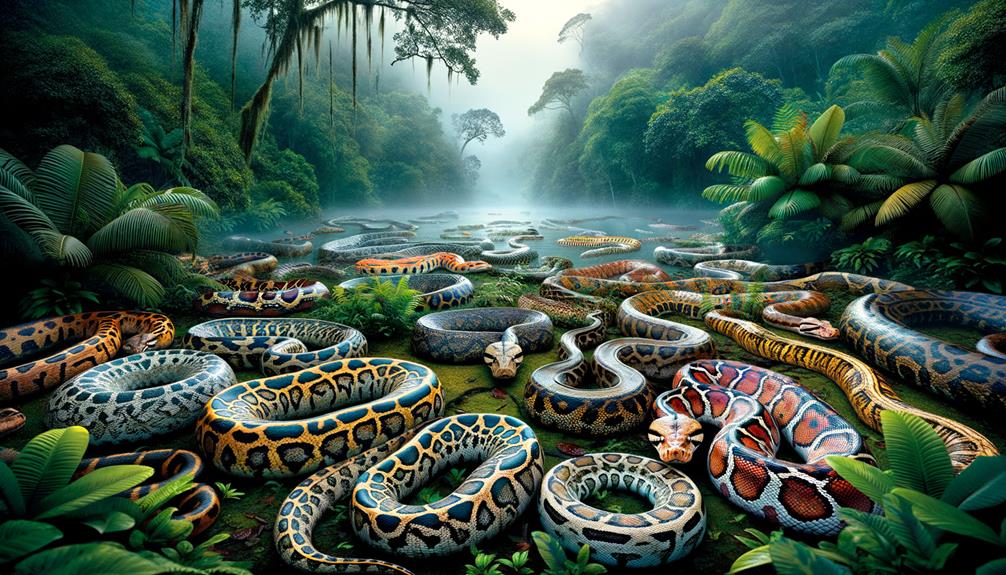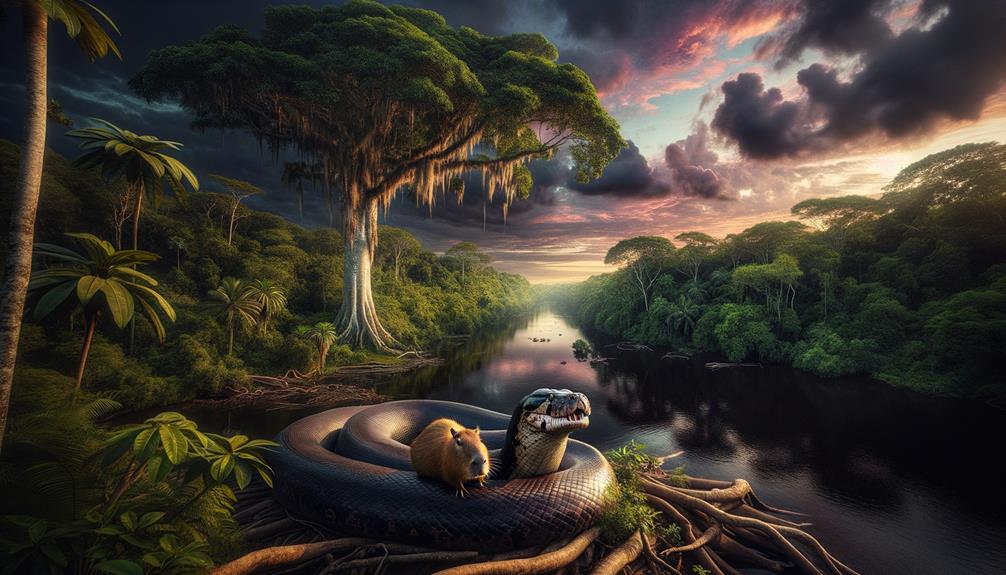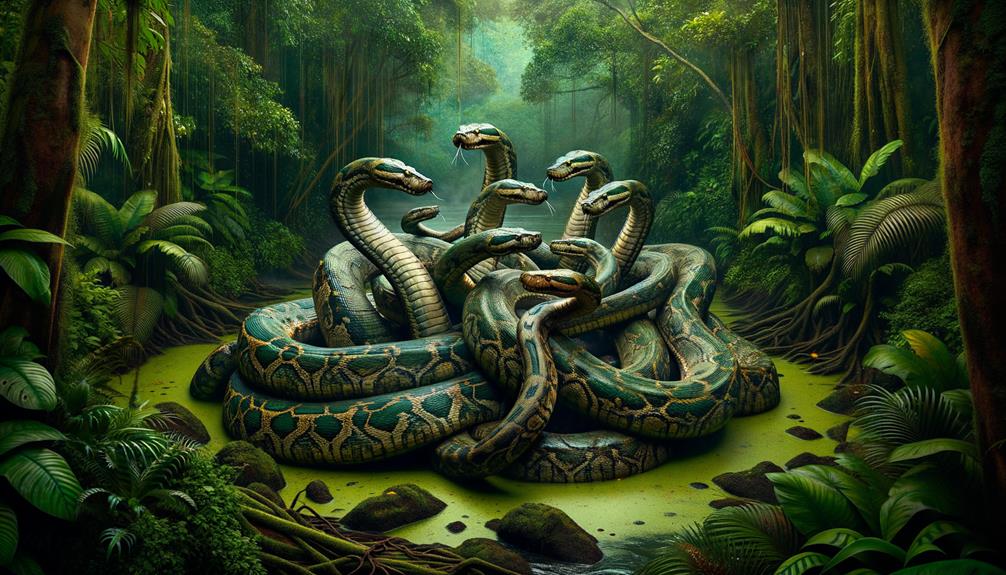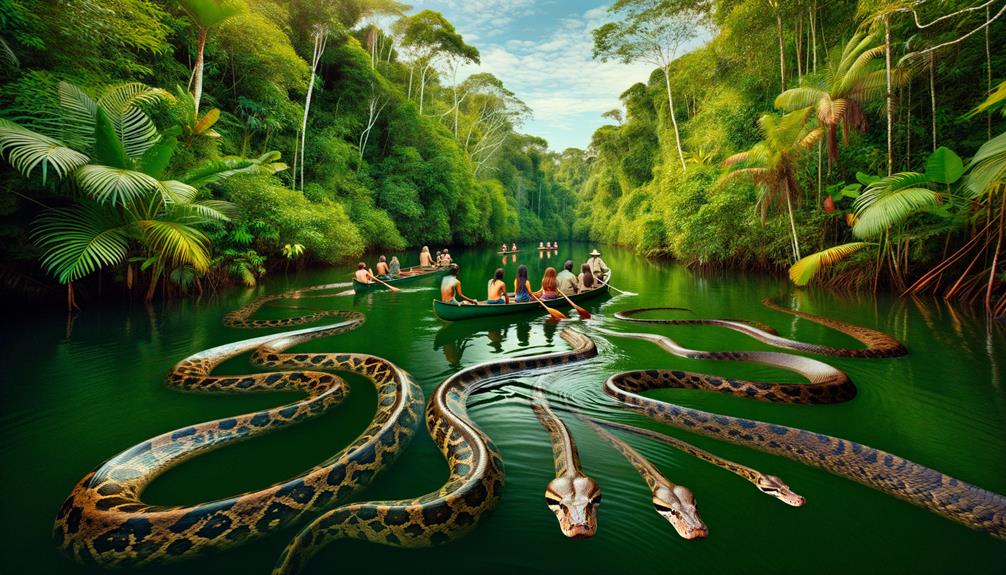During a trip to the Amazon River Basin, I spotted a Green Anaconda gliding through the murky waters. It was a perfect example of how these snakes have adapted to their environment. This sighting highlighted the rich variety of life in the Amazon. From the enormous Green Anaconda to the harder-to-find Dark-Spotted species, each type plays a key role in the ecosystem. Their hunting methods, breeding habits, and food choices tell us a lot about how this complex natural system works. Studying these patterns can teach us about wider ecological rules, but there's still a big gap in our knowledge about certain anaconda behaviors.
Anacondas' Natural Habitat
Anacondas make their home in the lazy waters of the Amazon and Orinoco basins. These massive snakes prefer calm streams, rivers, and swampy areas, where they can easily hunt and blend in along riverbanks, fallen logs, and sandy shores. As creatures comfortable both in and out of water, anacondas swim like pros, reaching speeds up to 6 meters per second underwater. This skill helps them chase down prey and dodge threats with ease.
In the thick Amazon jungle, anacondas' dark green skin with black oval spots works like a charm for hiding among the lush, shady plants. This natural camouflage keeps them hidden from both their next meal and anything that might want to eat them. These giant snakes are night owls, coming alive when it's dark to hunt and roam. They're loners most of the time, only getting together to mate, which makes them hard to spot in the vast Amazon.
Getting to know anacondas' habitat shows us how they've adapted to survive, and gives us a peek into the delicate balance of life in the Amazon's rich and varied ecosystem.
Anaconda Species Diversity

The Amazon river basins are home to a variety of anaconda species, each with its own unique traits and roles in the ecosystem. These massive snakes are a key part of the region's rich wildlife.
The Green Anaconda stands out as the largest of the bunch. Known for its impressive size and strength, it's a top predator in the Amazon. On the other hand, the Yellow Anaconda, while smaller, shows off the group's diversity with its varied diet of birds, fish, and small mammals.
Less common are the Dark-Spotted Anaconda and the Bolivian Anaconda. These rarer species live in specific parts of the Amazon basins, adding to the area's complex web of life. Each type of anaconda has developed special features to thrive in its particular habitat, showing just how adaptable these snakes can be.
The different anaconda species highlight the incredible variety of life in the Amazon. From the mighty Green Anaconda to the less-known Bolivian Anaconda, each plays a unique part in keeping the ecosystem balanced. Their presence serves as a reminder of the importance of preserving these diverse habitats.
Hunting and Diet

Anacondas dominate the Amazon's food chain, using their massive size and strength to catch prey. These snakes target a range of animals, from capybaras and tapirs to caimans, lizards, birds, and smaller reptiles.
Their hunting technique is both clever and effective. Anacondas wrap around their victims, squeezing tighter with each exhale until the prey suffocates. This method allows them to swallow their catch whole, which suits their slow digestion. Depending on the meal's size, it can take days or even weeks to fully digest.
Key prey items include:
- Capybaras: A favourite snack, offering plenty of calories.
- Caimans: Showing off the anaconda's ability to take down tough opponents.
- Rodents: Helping to keep pest numbers in check.
- Birds and lizards: Smaller treats that round out their diet.
However, habitat loss is making it harder for anacondas to find food.
These snakes' eating habits showcase their adaptability and underscore their key role in keeping the Amazon's ecosystem in balance. By preying on various animals, anacondas help control populations and maintain the intricate web of life in this rich environment.
Reproductive Behavior

When anacondas get frisky in April and May, female snakes release special scents that drive the boys wild. This kicks off a mating frenzy where multiple males wrap themselves around a single female, creating what's known as a 'breeding ball'.
Male anacondas have tiny leg-like structures near their rear ends, which they use to get the females in the mood. This hands-on approach boosts their chances of successfully passing on their genes. These massive snakes don't lay eggs; instead, females carry their young internally for about six months before giving birth to 20 to 40 live babies.
Baby anacondas start life at around 70-80 cm long, but many don't make it to adulthood due to hungry predators. Studying how these snakes mate and reproduce is key to keeping tabs on their numbers in the Amazon. This knowledge helps scientists come up with smart ways to protect anacondas in the wild, ensuring these impressive creatures stick around for years to come.
Conservation Efforts

Safeguarding anacondas in the Amazon relies heavily on preserving their natural habitat from logging and human expansion. Ongoing conservation work is vital to maintain the fragile ecosystem of the Amazon River Basins. Anacondas are key players in this environment, and their health reflects the overall state of their surroundings. With targeted approaches, we can help ensure these impressive snakes continue to thrive.
Major conservation projects include:
- Public Education: Informing people about anacondas' role in the ecosystem builds support for protection measures.
- Sustainable Tourism: Encouraging environmentally friendly visitor practices helps anacondas maintain their natural behaviors.
- Species Tracking: Keeping tabs on anaconda numbers provides crucial information to adapt protection strategies as needed.
- Working with Locals: Teaming up with nearby communities ensures long-lasting conservation practices that also benefit residents.
- Scientific Partnerships: Joining forces between researchers and conservation groups boosts the impact of protection programs.
Each of these efforts plays a crucial part in the overall plan to protect Amazon anacondas. By zeroing in on habitat conservation, responsible tourism, and community involvement, we're working towards a sustainable future for anacondas and the many other creatures that call the Amazon River Basins home.
Frequently Asked Questions
Are There Anacondas in the Amazon River?
Anacondas definitely call the Amazon River home. These massive snakes, which can grow longer than 22 feet, are skilled swimmers that hunt a variety of prey, including fish, birds, and mammals. Spotting one of these impressive reptiles in their natural environment can be an exhilarating experience for wildlife enthusiasts and researchers alike. While they're not as common as some might think, anacondas play a crucial role in the Amazon's ecosystem, helping to maintain the balance of various animal populations in and around the river.
What Is the Largest Snake in the Amazon Basin?
The green anaconda reigns supreme as the Amazon basin's largest snake. These massive predators can stretch beyond 22 feet, dominating their habitat with impressive strength. My research into their behavior and ecology reveals their significant impact on the local ecosystem, as they hunt and consume a wide range of animals. Their size and power make them unrivaled in their environment, solidifying their position at the top of the food chain in this diverse region.
How Big Are River Anacondas?
River anacondas are truly massive creatures. These snakes can stretch to over 22 feet long and tip the scales at a whopping 500 pounds, earning them the title of the world's heaviest snake. The females are particularly impressive, capable of giving birth to between 60 and 100 live young in a single litter. This remarkable reproductive ability, combined with their sheer size, makes river anacondas a fascinating subject for nature enthusiasts and researchers alike.
Does Titanoboa Still Exist in Amazon?
Titanoboa, the colossal serpent of prehistory, hasn't slithered through the Amazon for millions of years. Fossil records show this massive snake went extinct about 60 million years ago, long before the modern Amazon rainforest took shape. Today, you won't find any living Titanoboas in South America or anywhere else on Earth. While the Amazon is home to many impressive reptiles, including large anacondas, none come close to the sheer size of their ancient relative. Titanoboa remains a fascinating subject for paleontologists, offering insights into Earth's past climates and ecosystems, but it's no longer part of our living world.



